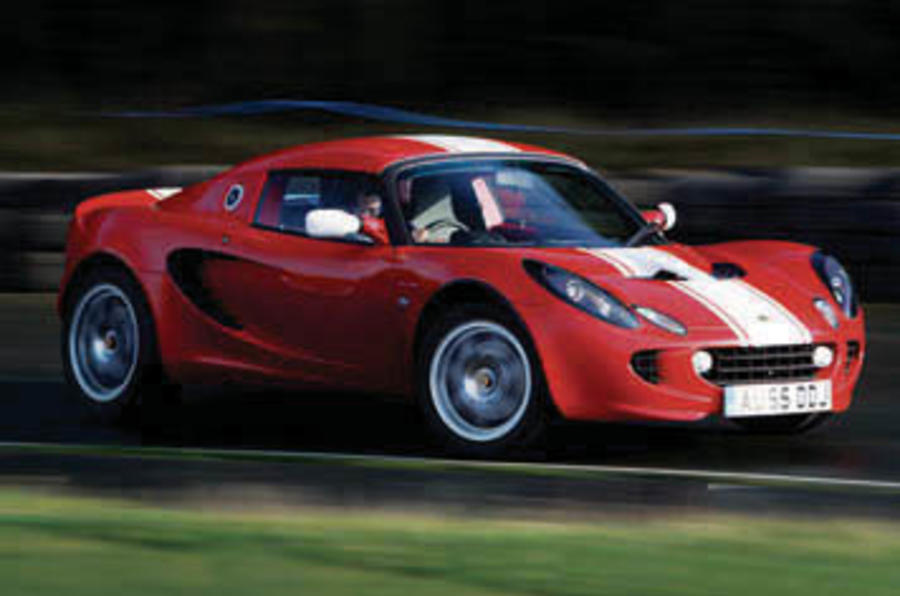IT WAS SOMEWHERE in the middle of 2002 that I lost my way with the Lotus Elise. This was not a case of falling out of love with Norfolk’s famous bundle of aluminium and plastic. In fact, nothing could have been further from the truth. Instead I found myself incapable of keeping up with the evolving specification changes.Using the generic label ‘an Elise’ to describe the car was no longer adequate. The simplicity of the original had been slightly corrupted by the need to expand the range with Sport 160s, track pack thingies and the upshot was a slightly confused gaggle of Elises.For 2006 this situation will change. The simplification process began in early 2004 with the switch to Toyota power, but even then there were specification avenues to explore. With the Elise now selling strongly in the States, the time has finally come to apply some common sense to the range and the upshot is this lightly revised car, called the Sports Racer.Does this mean we’re having the US Elise foisted on us? Not at all. There were some slight differences in damper specification between the two cars for 2005, but they were so minute that Lotus has moved to a single-specification car.This has been supplemented by a new standard-fit tyre. It’s now five years since the Mk2 car was launched with a bespoke Bridgestone RE040 tyre that helped bring about some remarkable chassis improvements over the original version. But just as the equipment packages and suspension variations became complicated over time, so did the tyre fittings.The RE040 was the base tyre, but there were a plethora of sticky Yokohama offerings available as well. Not only was this confusing for the buyer, but it was a complete nightmare for the production line. So the new standard tyre is a Yokohama Advan Neova AD07 LTS, but just to retain the element of confusion, the Bridgestone is still available as an aftermarket option.There is one aspect of the Sports Racer’s specification that doesn’t make quite such pleasant reading – traction control. And it wasn’t until I saw that phrase, then scanned a bit further and realised that anti-lock brakes were fitted and there’s the option of air-conditioning that it dawned on me how far the Elise has come since we witnessed those pictures of the original red press car back in 1996 – and read some of the most positive reviews ever lavished on a British sports car.Key to its success was the way it married innovative technologies with a more basic driving experience. That innovation is still pertinent in the extruded, bonded tub that forms the basis of this car, but as the Sport Racer ticks away at idle, it’s hard not to assume that the Elise has become something rather different to original intention.I mean, traction control on an Elise? I can remember taking delivery of mine in 1997 and boasting about it having no brake servo, let alone anti-lock brakes. But there it is, sitting rather like a discarded boiled sweet just to the right of the gearlever – a small black button that when depressed for three seconds disarms the electronic catching mitt and places control back with the right foot.I feel narrow-minded doing just this before moving away, but having a microprocessor dictate slip angle in a Lotus doesn’t seem right. For now it will remain inactive.Forged wheels may not sound too dramatic an option for 2006, but they shave a full 1.2kg per corner from this car, and that is a huge amount of unsprung mass. The kerbweight is still much higher than the original’s, though. Whereas a basic Mk1 Elise was just over 720kg, this car is now 840kg.But then in the meantime your average family hatchback has accumulated a few rolls of chub, so the same intrinsic differences still apply to the Elise driving experience in relation to just about every other car on sale. It appears tiny, endlessly agile and sprightly.And does it feel much different in 2006 form? To say that it doesn’t is a solid complement. The steering is more positive just off-centre and it still grips like a lunatic in the dry, although the Yokohamas’ more aggressive tread pattern reduces wet surface adhesion slightly. Otherwise it’s staple Elise: so supple and comfortable and yet so alert and roll-free you wonder if the Lotus chassis engineers had access to a different physics textbook to the others.But if there’s a reason to recommend this car above any other Toyota-engined variant I’ve driven before, it has nothing to do with the tyres, suspension or traction control. It’s the pedal box.The Elise 111R had an inch of dead travel in the brake pedal that was completely at odds with the whole driving experience. That has now been fixed with the introduction of an all-new extruded alloy set of pedals, along with a fly-by-wire throttle. The difference it makes has to be experienced at first hand because both throttle and brake now give the driver more confidence. In fact, they now have a consistency I last felt on the Mk1.After a few laps of Hethel it seems only fair to switch the traction control back on. After all, it was Lotus that finally made power steering work on a sports car, so it stands to reason it might be able to do something memorable with this aspect of modern electronics.This isn’t a stability programme with the ability to brake individual wheels; it’s a simple traction system. And wouldn’t you know it, the boys have worked their magic again. Not to the extent that it redefines the driving experience, but because they’ve been allowed to retard any kind of intervention until it is absolutely necessary.You will still be able to indulge in cute little slides, but the point at which the Elise has always become more aggressive is removed. Out on the road you just don’t know the system is there. It is what traction control was always intended to be: a safety device for extreme circumstances. If I drove an Elise regularly the temptation would be to leave it on permanently.Value is another original Elise commodity that will return next year. Throwing the toy shop at an Elise in 2005 resulted in a £38,000 car, too much money for a 189bhp four-cylinder sportster, however talented it might have been. But the Sport Racer is a much more palatable £31,995. And you can have it in red with some stripes.Progress might mean extra weight, but the Elise remains unique not only at the price, but in the entire marketplace. If mass is the penalty for being considered an everyday car and available for more people to enjoy then it’s worth the sacrifice.Nine years after it changed the way we all perceive sports cars, the Elise remains a singularly British, unconventional and desirable proposition. Even with traction control.Chris Harris
'06 changes manage to update the icon without losing its soul. Still a masterpiece.
Close
Back to top





















Add your comment